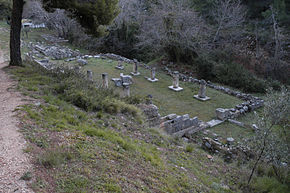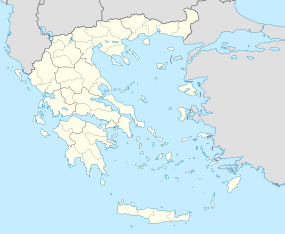Amphiareion of Oropos
| Άμφιαρείον Ωρωπού | |

View of the Temple of Amphiaraos.
|
|
| Location | Markopoulo Oropou, Attica, Greece |
|---|---|
| Region | Attica |
| Coordinates | 38°17′29″N 23°50′44″E / 38.29139°N 23.84556°ECoordinates: 38°17′29″N 23°50′44″E / 38.29139°N 23.84556°E |
| Type | Sanctuary |
| History | |
| Founded | 5th century BCE |
| Periods | Hellenistic to Roman |
| Satellite of | Athens |
| Site notes | |
| Condition | Ruined |
| Ownership | Public |
| Management | 2nd Ephorate of Prehistoric and Classical Antiquities |
| Public access | Yes |
| Website | Amphiareio, Oropos |
The Amphiareion of Oropos (Greek: Άμφιαρείον Ωρωπού), situated in the hills 6 km southeast of the fortified port of Oropos, was a sanctuary dedicated in the late 5th century BCE to the hero Amphiaraos, where pilgrims went to seek oracular responses and healing. It became particularly successful during the 4th century BCE, to judge from the intensive building at the site. The hero Amphiaraos was a descendant of the seer Melampos and initially refused to participate in the attack on Thebes (detailed in the Seven Against Thebes of Aeschylus) because he could foresee that it would be a disaster. In some versions of the myth, the earth opens and swallows the chariot of Amphiaraos, transforming him into a chthonic hero. Today the site is found east of the modern town Markopoulo Oropou in the Oropos municipality of Attica, Greece
The sanctuary is located 37.2 km NNE of Athens at a sacred spring; it contained a temple of Amphiaraos (with an acrolithic cult statue), as well as a theater, stoa, and associated structures. The temenos extended for some 240 metres northeast from the Temple of Amphiaraos (hence Amphiareion) along a streambed. The cult, which was both public and private, dates to the 5th century BCE. There was an upswing in the sanctuary’s reputation as a healing site during the plague that hit Athens in the late 5th BCE Herodotus relates that the oracular response of this shrine was one of only two correct answers to the test put to them all by the Lydian king Croesus. There were many dedications from Greeks, notable Romans, and others, many with inscriptions. On the southeast side of the streambed there are extensive remains of domestic structures as well as an unusually well-preserved clepsydra.
...
Wikipedia

